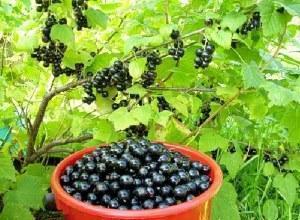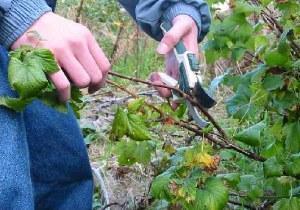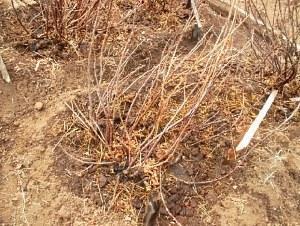How to care for currants in the fall?
 Currant is one of the most common types of shrubs, which includes 150 species. Everyone is familiar with the fruits black
and red currant... But what problems arise when growing currants? Do currants need care in the fall? How to properly care for red currants in autumn? How to properly care for black currants in autumn? These and other questions can be answered competently by reading the text below.
Currant is one of the most common types of shrubs, which includes 150 species. Everyone is familiar with the fruits black
and red currant... But what problems arise when growing currants? Do currants need care in the fall? How to properly care for red currants in autumn? How to properly care for black currants in autumn? These and other questions can be answered competently by reading the text below.
The currants pleased with their harvest in summer, presented them with delicious and healthy fruits. Now it's time to take care of her too. Indeed, with good care, a currant bush can grow in one place for up to twenty years, and this is a very valuable quality.
It is well known that currants are an unpretentious shrub that can withstand frost and heat with dignity, but this does not mean that you can bypass it with your attention. But how to provide proper care for currant bushes, few know. Let's dwell on this in more detail.
Basic rules for caring for black currants in autumn
There are several necessary operations for caring for black currant bushes, which must be performed in the fall and they consist in:
 Black currants can be pruned in spring and autumn, but due to the fact that currant buds swell very early in spring, pruning is best done in autumn. All sick, old, damaged and weak shoots growing in the middle of the bush and located low above the ground are pruned. Branches cut with a sharp pruner are removed from the site or burned to avoid spread diseases
Black currants can be pruned in spring and autumn, but due to the fact that currant buds swell very early in spring, pruning is best done in autumn. All sick, old, damaged and weak shoots growing in the middle of the bush and located low above the ground are pruned. Branches cut with a sharp pruner are removed from the site or burned to avoid spread diseases
Bush pruning is also intended to help shape the bush later on. All zero shoots are subject to cutting, only 6-8 of the most powerful branches are left on the bush. If this is not done in time, then the bush will thicken, it will develop poorly, and over time it will stop growing altogether. In addition to cutting out shoots, there is a procedure for shortening the branches of an adult bush by 1/3 to awaken the underground buds.
 There are different opinions about the processing of near-trunk circles. For example, the traditional school of land cultivation proves that in the fall the near-trunk circle of currants must be dug onto the bayonet of a shovel with a seam lapel, in order to neutralize harmful insects and their larvae.
There are different opinions about the processing of near-trunk circles. For example, the traditional school of land cultivation proves that in the fall the near-trunk circle of currants must be dug onto the bayonet of a shovel with a seam lapel, in order to neutralize harmful insects and their larvae.
Proponents of organic farming, on the contrary, speak out against digging and suggest mulching the tree trunks with compost, straw, leaves to preserve the air-capillary system in the soil.
Top dressing of black currant bushes in the fall should in no case be done with nitrogen fertilizers. The use of nitrogen at this time of the year will cause unnecessary shoot growth and interfere with the quality maturation of the branches, which will negatively affect their winter hardiness. With autumn feeding, 30 g of potassium chloride and 100 g of superphosphate are added under the bush.
 In addition to top dressing, it is very useful to add soil around the bush. A bucket of stale sawdust, peat and a glass of wood ash are poured onto each currant bush.
In addition to top dressing, it is very useful to add soil around the bush. A bucket of stale sawdust, peat and a glass of wood ash are poured onto each currant bush.
The filling should be at least 10 cm thick. It is not recommended to add manure, as the manure contains nitrogen in excess. It can be used only when persistent cold weather sets in.And there are also those gardeners who, instead of bedding, stubbornly sow the near-stem circle of shrubs with lawn grass or simply cover the bushes with cardboard.
How to care for red currants in autumn?
Red currant is more resistant to changes in climatic conditions than black currant. But this does not mean that she does not need certain care. And to get a good harvest for the next year, you just need to perform a few simple, easy operations. For red currants, care is carried out according to the same rules as for black currants, which are indicated above, however, much more time and skill should be given to the procedure for pruning a bush.
So, starting the autumn pruning, you need to start it by eliminating the thickening of the branches. A large number of shoots has a bad effect in the future on the quality and size of the fruit. When the rest period comes, it's time to start pruning.
Cut old ten-year-old branches, weak, damaged shoots, and branches growing into the ground. Cuts of red currants take a very long time to heal, so wounds larger than 8 mm are treated with garden varnish. In addition, red currant bushes are susceptible to fungal disease. A grayish bloom appears on green leaves, which later turns brown.
It is very important to cut off all damaged areas of the bush in time. Shoots are also cut out, affected by the glass caterpillar, which by laying eggs in the bark and core inhibit the growth of the bush.
Observing the elementary rules for caring for currants in the fall, the garden plot is decorated with full-fledged bushes and is provided with a rich harvest of delicious fruits.
Currants are a very healthy and tasty berry, but they require good care. I have been growing currants for a long time, over the years I have developed personal experience. In the fall, I do not dig up the trunk circles, but mulch with leaves. I feed in autumn with superphosphate (under a bush). I also sprinkle the bush with sawdust mixed with ash, as described in the article. I always have a good harvest of currants.
The best soil for the growth of currants is chernozem loam, but it can grow on other soils, both light and dense, as long as the place is fertile and moist; to comply with the first condition, light and infertile soils are well fertilized after 2-3 years and, in addition, they are watered with liquid fertilizers during the summer in order to maintain moisture in the soil; in dry areas, currants should be planted not in the beds, but in grooves (red and white currants tolerate dry soil more easily than black currants)
I also grow, already, now I am 70 years old